Locomotives of the London and North Western Railway
Locomotives of the London and North Western Railway. The London and North Western Railway (LNWR) Locomotive Department was headquartered at Crewe from 1862. The Crewe Works had been built in 1840–43 by the Grand Junction Railway.
Locomotives inherited from constituent companies

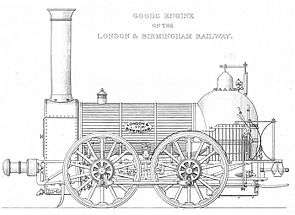
The LNWR was formed in 1846 with the merger of the Grand Junction Railway, the London and Birmingham Railway and the Manchester and Birmingham Railway.
The GJR and the Liverpool & Manchester Railway initially had their workshops at Edge Hill. The London & Birmingham workshops were at Wolverton. The Grand Junction built a new works at Crewe which opened in 1843, while the Manchester and Birmingham's works was at Longsight.
While the GJR and M&BR locos were mainly by Robert Stephenson and Sharp Bros, the L&B's were mostly "Bury" types – indeed Edward Bury was its locomotive superintendent. On the GJR, breakages of the inside-cylinder engines' crank axles led to the redesign of several with outside cylinders under locomotive superintendent Francis Trevithick. These later became known as the "Old Crewe" types.
After the creation of the LNWR in 1846, Crewe and Wolverton became headquarters of the Northern and Southern Divisions respectively, with Longsight as the headquarters of the North Eastern Division.
In 1922 the LNWR merged with the Lancashire and Yorkshire Railway and the North London Railway to form a larger company still called the LNWR.
See:
Locomotives under the LNWR
The first Northern Division Locomotive Superintendent (at Crewe works) was Francis Trevithick, son of Richard Trevithick, who continued to build the basic 2-2-2 and 2-4-0 designs. Alexander Allan was Works Manager at Crewe from 1843 to 1853.
- 4-2-2 Cornwall (1847)
In 1857 the North Eastern Division locomotive department, with headquarters at Longsight, was absorbed into that of the Northern Division. Trevithick was dismissed and returned to Cornwall with an honorarium, and was replaced at Crewe by John Ramsbottom as Northern Division Superintendent. Ramsbottom began to standardise and modernise the locomotive stock, initially replacing the 2-4-0 goods engines with his "DX" 0-6-0, of which over 900 were built at Crewe from 1858 to 1872.
The first Southern Division Locomotive Superintendent was Edward Bury who had been in charge of the London and Birmingham Railway locomotive department at Wolverton since before that railway opened. He resigned in 1847 and later became General Manager of the Great Northern Railway. His successor at Wolverton was James McConnell who had previously worked for the Birmingham and Gloucester Railway at their Bromsgrove works. Among the classes built under his superintendence were the very successful 2-2-2 "Bloomers", developed from a Bury design, and the Wolverton Express Goods 0-6-0 class, built from 1854 to 1863. The Southern Division's trains were longer and heavier, and 0-6-0 locos had been introduced as early as 1845.

There were distinct differences between the Southern and Northern Division locomotive policies. Wolverton had been set up in 1838 for repair work only, the locomotives being purchased from outside firms, whereas Crewe, from its foundation in 1843, was a locomotive-building works. Only a dozen locomotives were built at Wolverton from 1845 to the end of 1854, but in the following year construction started in earnest, and another 154 were completed in 1855–1863. The Southern Division engines were bigger, heavier and more expensive than those of the Northern Division, and after a disagreement with the cost-conscious Chairman, Richard Moon, in 1862 McConnell was obliged to resign. The Southern and Northern locomotive departments were amalgamated, and John Ramsbottom became Locomotive Superintendent of the entire LNWR, his headquarters remaining at Crewe. Locomotive building and repairing were gradually run down at Wolverton, which became the LNWR's carriage works in 1865.
All LNWR locomotives were painted black from 1873; for many years the goods engines were plain black, but passenger engines were given red, white and blue-grey lining, and most goods engines were similarly lined from the 1890s. Before 1873 locomotives had been green with black lines, and this seems to have been the normal livery from London & Birmingham and Grand Junction times.
In the 1850s on the Southern Division, McConnell had some of his express engines painted green with more elaborate patterns of lining in various colours, and in 1861–62 a few Southern Division engines were painted a very dark plum-red. The widespread belief that McConnell's engines were painted vermilion is incorrect, despite its constant repetition.
John Ramsbottom (1857–1871)
| Image | Class | Type | Quantity | Manufacturer | Date | LMS Class | LMS Numbers | Notes |
|---|---|---|---|---|---|---|---|---|
 | No.173 Cornwall | 2-2-2 | 1 | Crewe Works | 1847–1858 | — | — | Rebuilt as 2-2-2 (1858) |
| 271 | 0-6-0 | 7 | Sharp, Stewart & Co. | 1857 | — | — | [1] | |
 | DX | 0-6-0 | 943 (including 86 for the L&YR) | Crewe Works | 1858–72 | — | — | [2] 500 later rebuilt as 'Special DX' |
| D | 0-6-0 | 1 | Longsight Works | 1859 | — | — | [3] | |
| Ostrich | 0-6-0 | 2 | Beyer, Peacock & Co. | 1859 | — | — | [3] | |
 | Problem | 2-2-2 | 60 | Crewe Works | 1859–65 | — | — | [4] Also called Lady of the Lake class |
| Crewe Works Tramway | 0-4-0T | 7 | Crewe Works | 1862–1875 | — | — | [5][6] 18-inch gauge. Named Tiny, Pet, Nipper, Topsy, Midge, Dickie, and Billie. | |
| | Wolverton Express Goods | 0-6-0 | 10 | Wolverton Works | 1863 | — | — | [7] McConnell design, last to be built at Wolverton |
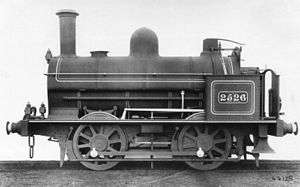 | 4ft Shunter | 0-4-0ST | 36 | Crewe Works | 1863–70 | — | 7206-7210 | [8] 835 |
 | Samson | 2-4-0 | 90 | Crewe Works | 1863–79 | — | — | [9] |
 | Newton | 2-4-0 | 96 | Crewe Works | 1866–73 | — | — | [10] All 'renewed' as "Renewed Precedent" class |
 | Special Tank | 0-6-0ST | 260 | Crewe Works | 1870–80 | 1F | 7220–7457 | [11] |
 | Metropolitan Tank | 4-4-0T | 16 | Beyer, Peacock & Co. | 1871–72 | — | — | [12] Built by Beyer-Peacock. Same design as used by Metropolitan. 10 rebuilt as 4-4-2T and one as compound (see below) |
Francis Webb (1871–1903)
| Image | Class | Type | Quantity | Manufacturer | Date | LMS Class | LMS Numbers | Notes |
|---|---|---|---|---|---|---|---|---|
 | B | 2-2-0ST | 1 | Edward Bury & Co. Crewe Works | 1835–76 | — | — | [13]Worked C&HPR from 1835–1873; Crewe Works until scrapped May 1876 |
 | 1201 | 0-4-0ST | 10 | Crewe Works | 1872 | — | 7211–7212 | [14] |
 | 17in Coal Engine | 0-6-0 | 500 | Crewe Works | 1873–92 | 2F | 8088-8314 | [15] 45 rebuilt as pannier-tanks (see below) |
 | Precursor | 2-4-0 | 40 | Crewe Works | 1874–79 | — | — | [16] |
 | Precedent | 2-4-0 | 70 | Crewe Works | 1875–82 | — | — | [17] 62 'renewed' and 8 rebuilt as "Renewed Precedent" class |
 | 2234 | 2-4-0T | 50 | Crewe Works | 1876–80 | 1P | 6420–6434 | [18] nicknamed “Chopper Tanks” |
 | 4′ 6″ Tank | 2-4-2T | 220 | Crewe Works | 1879–98 | 1P | 6515–6600 | [19] |
 | 18in Goods | 0-6-0 | 310 | Crewe Works | 1880–1902 | 2F | 8315–8624 | [20] Nicknamed “Cauliflowers” |
 | 2360 | 0-4-0WT | 10 | Crewe Works | 1880–82 | — | 7200–7205 | [21] Double-ended, oil-fired dock shunters; 4 engines used as service stock |
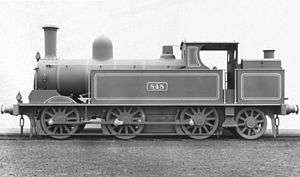 | Coal Tank | 0-6-2T | 300 | Crewe Works | 1881–97 | 1F | 7550–7841 | [22] |
 | Special DX | 0-6-0 | 500 | Crewe Works | 1881–98 | ? | 8000–8087 | [2] Rebuilds of DX |
 | Experiment | 2-2-2-0 | 30 | Crewe Works | 1882–84 | — | — | [23] 3-cylinder Compound |
 | No.2062 | 4-2-2-0 | 1 | Crewe Works | 1884 | — | — | [24] 3-cylinder Compound rebuild of Metropolitan tank |
 | Dreadnought | 2-2-2-0 | 40 | Crewe Works | 1884–88 | — | — | [25] 3-cylinder Compound |
 | No.687 | 2-2-2-2T | 1 | Crewe Works | 1885 | — | — | [26] 3-cylinder Compound "Fore-and-Aft" |
 | No.600 | 2-2-2-2T | 1 | Crewe Works | 1887 | — | — | [26] 3-cylinder Compound |
 | No.777 | 2-2-4-0T | 1 | Crewe Works | 1887 | — | — | [26] 3-cylinder Compound |
 | Renewed Precedent | 2-4-0 | 166 | Crewe Works | 1887–1901 | 1P | 5000–5079 | [27] Nominal renewals of 96 Newtons & 80 Precedents |
| | Teutonic | 2-2-2-0 | 10 | Crewe Works | 1889–90 | — | — | [28] 3-cylinder Compound |
 | Waterloo | 2-4-0 | 90 | Crewe Works | 1889–96 | 1P | 5080–5109 | [29] Also known as Whitworth Class |
 | 5′ 6″ Tank | 2-4-2T | 160 | Crewe Works | 1890–97 | 1P | 6601–6757 | [30] |
| 1201 | 0-4-0ST | 10 | Crewe Works | 1892 | 7213–7216 | [14] 3 rebuilt as 0-4-2T Crane Tanks | ||
 | Metropolitan Tank | 4-4-2T | 10 | Crewe Works | 1892 | — | — | [12] Rebuilds of Metropolitan 4-4-0T above |
| No.2524 | 0-8-0 | 1 | Crewe Works | 1892 | — | — | [31] Basis of "C" class, later rebuilt as D, then G1. | |
 | Greater Britain | 2-2-2-2 | 10 | Crewe Works | 1892–94 | — | — | [28] 3-cylinder Compound |
 | A | 0-8-0 | 111 | Crewe Works | 1893–1900 | [32][33] 3-cylinder Compound, all rebuilt as C (15), C1 (34) or D (62) | ||
 | 835 | 0-4-2WT | 5 | Crewe Works | 1894 | — | — | [34] Crane Tank |
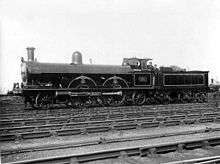 | John Hick | 2-2-2-2 | 10 | Crewe Works | 1894–98 | — | — | [35] 3-cylinder Compound |
| | 317 | 0-4-2ST | 20 | Crewe Works | 1896–1901 | 1P | 6400-6419 | [36][37] also known as “Dock Tank” or “Bissel Tank” |
| Iron Duke | 4-4-0 | 1 | Crewe Works | 1897 | — | — | [38] Initially 4-cylinder simple, converted to Compound, then to "Renown" | |
| Black Prince | 4-4-0 | 1 | Crewe Works | 1897 | — | — | [38] 4-cylinder Compound, rebuilt as "Renown" | |
 | 18in Tank | 0-6-2T | 80 | Crewe Works | 1898–1902 | 1P | 6860-6936 | [39] |
 | Jubilee | 4-4-0 | 38 | Crewe Works | 1897–1900 | 2P | 5110-5117 | [40] 4-cylinder Compound, all but 3 rebuilt as "Renown"s |
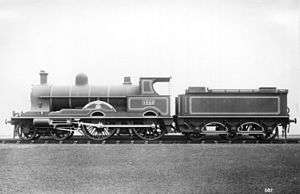 | Alfred the Great | 4-4-0 | 40 | Crewe Works | 1901–03 | 2P | 5118-5130 | [41] 4-cylinder Compound, 33 rebuilt as 'Renown' |
 | B | 0-8-0 | 170 | Crewe Works | 1901–04 | 3F | 8900-8952 | [42][43] 4-cylinder Compound, most rebuilt as E (26), F (10), G (32) or G1 (91) |
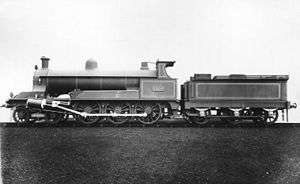 | 1400 | 4-6-0 | 30 | Crewe Works | 1903–05 | — | — | [44] 4-cylinder Compound, nicknamed “Bill Baileys”, all scrapped before grouping |
George Whale (1903–1909)
| Image | Class | Type | Quantity | Manufacturer | Date | LMS Class | LMS Numbers | Notes |
|---|---|---|---|---|---|---|---|---|
| C | 0-8-0 | 15 | Crewe Works | 1904–06 | 4F | 8953–8967 | [45] Simple rebuilds of Class A, 5 rebuilt as G1 | |
 | E | 2-8-0 | 26 | Crewe Works | 1904–07 | 3F | 9600–9609 | [46] Rebuilds of Class B, small boiler, 2 rebuilt as F, 18 as G1. |
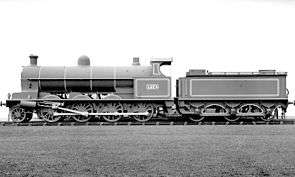 | F | 2-8-0 | 12 | Crewe Works | 1904–07 | 3F | 9610–9615 | [47] Rebuilds of Class B (10) and E (2), large boiler. 10 later rebuilt as G1 |
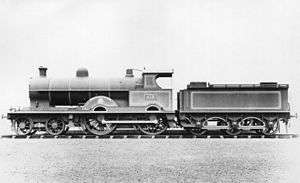 | Precursor | 4-4-0 | 130 | Crewe Works | 1904–07 | 2P/3P | 5187–5319 | [48] Many later equipped with superheaters |
 | Square Saddle Tank | 0-6-0PT | 45 | Crewe Works | 1905–07 | 1F | 7458–7502 | Rebuilds of Coal (tender) engines |
| | Experiment | 4-6-0 | 105 | Crewe Works | 1905–10 | 3P | 5450–5554 | [49] |
 | D | 0-8-0 | 63 | Crewe Works | 1906–09 | 4F | 9002–9064 | [50] Simple rebuilds of Class A and no.2524. All later rebuilt as G1 |
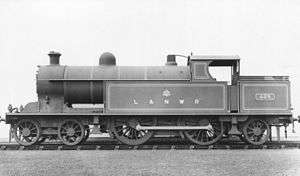 | Precursor Tank | 4-4-2T | 50 | Crewe Works | 1906–09 | 2P | 6780–6829 | [51] |
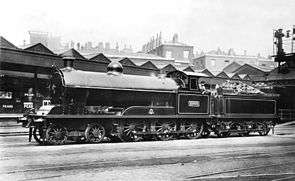 | 19in Goods | 4-6-0 | 170 | Crewe Works | 1906–09 | 4F | 8700–8869 | [52] |
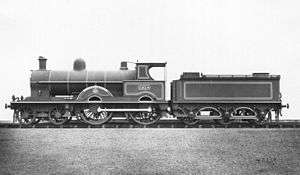 | Renown | 4-4-0 | 70 | Crewe Works | 1908–24 | 2P | 5131–5186 | Simple rebuilds of 'Jubilee' & 'Alfred the Great' classes |
| | C1 | 0-8-0 | 34 | Crewe Works | 1909 | 3F | 8968–9001 | [53] Simple rebuilds of Class A |
Charles John Bowen Cooke (1909–1920)
With a reasonably comprehensive fleet, Bowen Cooke arranged exchanges with other railways in 1909 and 1910 to assess the scope for improvements, among which was superheating.
| Image | Class | Type | Quantity | Manufacturer | Date | LMS Class | LMS Numbers | Notes |
|---|---|---|---|---|---|---|---|---|
 | George the Fifth | 4-4-0 | 90 | Crewe Works | 1910–15 | 3P | 5320–5409 | [54] Superheated, 80 original, 10 conversions of 'Queen Mary's |
| Queen Mary | 4-4-0 | 10 | Crewe Works | 1910 | — | — | [55] All later converted to George the Fifth class | |
 | G | 0-8-0 | 92 | Crewe Works | 1910 | 4F | 9065–9153 | [56] 60 new, 32 rebuilds of B. All rebuilt as G1 |
 | 2665 | 4-6-2T | 47 | Crewe Works | 1910–16 | 3P | 6950–6996 | [57] 12 built saturated, later had superheaters added, remainder began superheated. Nicknamed ‘Prince of Wales Tank’ |
 | Prince of Wales | 4-6-0 | 246 | Crewe Works (135) North British Loco (20) Wm Beardmore & Co. (91) | 1911–24 | 3P | 5600–5845 | [58] Superheated |
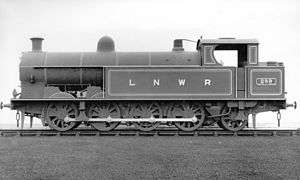 | 1185 | 0-8-2T | 30 | Crewe Works | 1911–17 | 4F | 7870–7899 | [59] |
 | G1 | 0-8-0 | 449 | Crewe Works | 1912–18 | 6F | 9154–9394 | [60] Superheated, boiler 160psi. 170 new, rest rebuilds of B (91), C (5), D (63), E (18), F (10), G (92) |
 | Claughton | 4-6-0 | 130 | Crewe Works | 1913–21 | 5P | 5900–6029 | [61] Superheated, 42 later 'renewed' as Patriots by LMS |
 | MM | 2-8-0 | 30 | R. Stephenson & Co. (2) North British Loco (28) | 1919 | 7F | 9616–9645 | [62] Robinson ROD type. Bought from the government. Another 151 on hire, but returned. |
H. P. M. Beames (1920–1922)
| Image | Class | Type | Quantity | Manufacturer | Date | LMS Class | LMS Numbers | Notes |
|---|---|---|---|---|---|---|---|---|
 | G2 | 0-8-0 | 60 | Crewe Works | 1921–22 | 7F | 9395–9454 | [63] Superheated, boiler 175 psi. All new engines |
 | 380 | 0-8-4T | 30 | Crewe Works | 1923–24 | 5F | 7930–7959 | [64] Superheated |
George Hughes (1922)
In 1922 the LNWR merged with the Lancashire and Yorkshire Railway (L&YR) to form a larger company still called the LNWR. George Hughes, formerly CME of the L&YR became CME of the LNWR. A year later the large company was grouped into the LMS and Hughes became CME of the LMS.
Locomotives of the North London Railway

4-4-0T (inside cylinders)

4-4-0T (outside cylinders)
In the early days, locomotives were bought from outside builders but, from 1863, they were built in the North London Railway's workshops at Bow, London.
William Adams (1854–1873)
- 4-4-0T (16" inside cylinders) built 1863-1865
- 4-4-0T (17" inside cylinders) built 1865-1869
- 4-4-0T (17" outside cylinders) built 1868-1876
- 4-4-0T (17½" outside cylinders) built 1876-?
John C. Park (1873–1893)
Influence on LMS policy
Crewe's influence on the locomotives of the London, Midland and Scottish Railway was less than that of its great rival the Midland Railway. However, the LMS did produce an unsuccessful "Midlandised" version of the G class 0-8-0s, see LMS Class 7F 0-8-0.
Preservation
Preserved L&NWR locomotives are:
| Image | LNWR No. | LNWR class | Type | Manufacturer | Serial No. | Date | Notes |
|---|---|---|---|---|---|---|---|
 | 116 | 0-4-2 | Todd, Kitson and Laird | 1838 | ex Liverpool and Manchester Railway 57 Lion; static display, Museum of Liverpool | ||
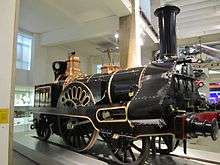 | 1868 | 2-2-2 | Crewe Works | — | 1845 | ex Grand Junction Railway 49 Columbine; static exhibit (no tender); National Collection, Science Museum, London (tender in storage at Wroughton, Wiltshire) | |
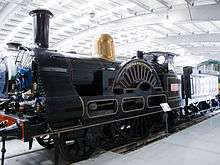 | 3020 Cornwall | 2-2-2 | Crewe Works | — | 1847 | Static exhibit; National Collection, Shildon | |
.jpg) | Pet | Crewe Works Tramway | 0-4-0ST | Crewe Works | — | 1865 | 18-inch gauge; static exhibit; National Collection, York |
| | 1439 | 835 | 0-4-0ST | Crewe Works | 842 | 1865 | Renumbered 1985 in 1885 and 3042 in 1891, sold to industry. To Staffordshire County Museum |
| | 1054 | Coal Tank | 0-6-2T | Crewe Works | 2979 | 1888 | LMS 7799, BR 57926; |
| | 790 Hardwicke | Renewed Precedent | 2-4-0 | Crewe Works | 3286 | 1892 | LMS 5031; static exhibit; National Collection, York |
| | 485 | G2 | 0-8-0 | Crewe Works | 5662 | 1921 | LMS 9395 |
| | 2650 | NLR Class 75 | 0-6-0T | Bow Works | 181 | 1880 | ex North London Railway 116, née 76; acquired 1909. Became LMS 7505, 27505 from 1934; BR 58850. Awaiting overhaul at Bluebell Railway |
A full-size working replica of an LNWR Bloomer Class locomotive was begun at Tyseley in 1986, was 90% completed by 1990, but has never been finished (2016).
Another full-size replica of the same type (but non-working) was built in Milton Keynes, and was exhibited outside the station there from 1991; it is now (2016) stored in Wolverton railway works.
A miniature one-sixth scale locomotive 'Orion' was built by G R S Darroch during his time at Crewe Works. It is based on the LNWR Alfred the Great Class and is the only surviving Crewe built Webb Compound. (Completed circa 1910-12) The locomotive is in the ownership of the Stephenson Locomotive Society and currently based at Shildon Locomotion Museum.
References
- ↑ Baxter 1978, pp. 123–124.
- 1 2 Baxter 1978, pp. 124–157.
- 1 2 Baxter 1978, p. 124.
- ↑ Baxter 1978, pp. 116–118.
- ↑ Baxter 1978, pp. 177.
- ↑ Baxter 1979, pp. 185.
- ↑ Baxter 1978, pp. 157–158.
- ↑ Baxter 1978, pp. 122–123.
- ↑ Baxter 1978, pp. 118–120.
- ↑ Baxter 1978, pp. 120–122.
- ↑ Baxter 1978, pp. 158–177.
- 1 2 Baxter 1979, pp. 201–202.
- ↑ Palmer, John (7 May 2006). "The second CHPR loco, 1835-1876". WIRKSWORTH Parish Records 1600-1900. John Palmer. Retrieved 28 April 2016.
- 1 2 Baxter 1979, pp. 203–204.
- ↑ Baxter 1979, pp. 214–232.
- ↑ Baxter 1979, pp. 185–186.
- ↑ Baxter 1979, pp. 186–187.
- ↑ Baxter 1979, pp. 204–205.
- ↑ Baxter 1979, pp. 205–210.
- ↑ Baxter 1979, pp. 232–239.
- ↑ Baxter 1979, p. 204.
- ↑ Baxter 1979, pp. 240–247.
- ↑ Baxter 1979, p. 194.
- ↑ Baxter 1979, p. 202.
- ↑ Baxter 1979, pp. 194–195.
- 1 2 3 Baxter 1979, p. 210.
- ↑ Baxter 1979, pp. 188–191.
- 1 2 Baxter 1979, p. 196.
- ↑ Baxter 1979, pp. 191–193.
- ↑ Baxter 1979, pp. 210–213.
- ↑ Baxter 1979, p. 250.
- ↑ Baxter 1979, pp. 250–254.
- ↑ http://www.lnwrs.org.uk/GoodsLocos/Loco10.php
- ↑ Baxter 1979, pp. 213–214.
- ↑ Baxter 1979, pp. 196–197.
- ↑ Baxter 1979, p. 214.
- ↑ http://www.lnwrs.org.uk/GoodsLocos/Loco08.php
- 1 2 Baxter 1979, p. 197.
- ↑ Baxter 1979, pp. 247–249.
- ↑ Baxter 1979, pp. 197–199.
- ↑ Baxter 1979, pp. 199–201.
- ↑ Baxter 1979, pp. 254–202.
- ↑ http://www.lnwrs.org.uk/GoodsLocos/Loco11.php
- ↑ Baxter 1979, pp. 239–240.
- ↑ http://www.lnwrs.org.uk/GoodsLocos/Loco12.php
- ↑ http://www.lnwrs.org.uk/GoodsLocos/Loco14.php
- ↑ http://www.lnwrs.org.uk/GoodsLocos/Loco15.php
- ↑ Baxter 1979, pp. 260–264.
- ↑ Baxter 1979, pp. 265–268.
- ↑ http://www.lnwrs.org.uk/GoodsLocos/Loco13.php
- ↑ Baxter 1979, pp. 264–265.
- ↑ Baxter 1979, pp. 268–271.
- ↑ http://www.lnwrs.org.uk/GoodsLocos/Loco12.php
- ↑ Baxter 1979, pp. 272–275.
- ↑ Baxter 1979, p. 275.
- ↑ Baxter 1979, pp. 292–294.
- ↑ Baxter 1979, pp. 290–291.
- ↑ Baxter 1979, pp. 275–285.
- ↑ Baxter 1979, pp. 301–302.
- ↑ Baxter 1979, pp. 294–298.
- ↑ Baxter 1979, pp. 285–290.
- ↑ Baxter 1979, pp. 299–301.
- ↑ Baxter 1979, pp. 298–299.
- ↑ Baxter 1979, pp. 302–303.
- Baxter, Bertram (1978). Baxter, David, ed. British Locomotive Catalogue 1825–1923, Volume 2A: London and North Western Railway and its constituent companies. Ashbourne, Derbyshire: Moorland Publishing Company. ISBN 0-903485-51-6.
- Baxter, Bertram (1979). Baxter, David, ed. British Locomotive Catalogue 1825–1923, Volume 2B: London and North Western Railway and its constituent companies. Ashbourne, Derbyshire: Moorland Publishing Company. ISBN 0-903485-84-2.
- Reed, M. C. (1996). The London & North Western Railway. Atlantic Transport Publishers.
- Talbot, Edward (1985). An Illustrated History of LNWR Engines. Oxford Publishing Company.
- Yeadon, W. B. A Compendium of LNWR Locomotives 1912–1949, Volume 1: Passenger Tender Engines.
- Yeadon, W. B. A Compendium of LNWR Locomotives 1912–1949, Volume 2: Goods Tender Engines.
- Jack, Harry (2001). Locomotives of the LNWR Southern Division. ISBN 0-901115-89-4.
External links
| Wikimedia Commons has media related to London and North Western Railway steam locomotives. |